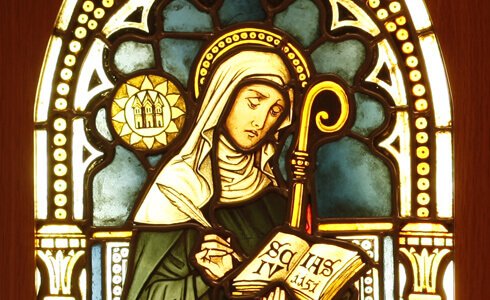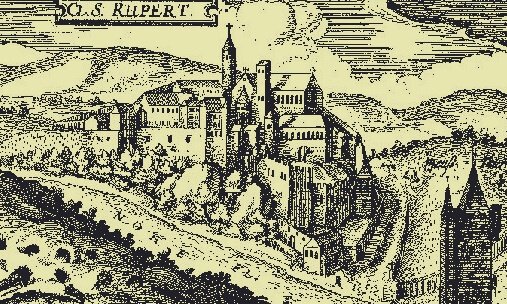Hildegard of Bingen: Biography of a Female Polymath


Written and verified by the psychologist Valeria Sabater
Hildegard of Bingen was a 12th-century German abbess. She was also a philosopher, theologian, composer, and poetess. Some say that she was the pioneer of opera, sexology, and scientific natural history.
Since she was a little girl, she was really passionate about knowledge. She wanted to understand nature. Despite the fact that her parents sent her to the Church at a very young age, she managed to find the resources to develop her intelligence and promote her thoughts, visions, and the mystical messages she received throughout her life.
Hildegard of Bingen left a huge legacy. She’s a clear example of how women, despite the evident constraints against them, have always managed to promote scientific progress.
“In the same vision I understood the writing of the prophets, the Gospels, and the other saints, and of certain philosophers, without any human instruction. And I expounded some of them, although I had scarcely any knowledge of literature, as an uneducated woman had taught me.”
-Hildegard of Bingen-

Hildegard of Bingen
She was born in 1098 near the Nahe and Rhine rivers in Bermersheim, Germany. She suffered from severe health problems from a young age. In her first years of life, an abbess named Jutta of Spanheim took care of her and taught her music and Latin, but didn’t teach her how to write. Thus, Hildegard of Bingen learned how to write on her own.
Some written documents, like the one by the monk Theoderich of Echternach, state that she had visions since she was eight years old. She was always conscious and aware during the visions. They were very intense visual and auditory hallucinations that she had throughout her whole life.
A vision that changed it all
When Hildegard of Bingen became an adult, her physical pain simply went away. It was an awakening for her. This allowed her to focus on what she was most passionate about: knowledge. She had science, natural history, and Greek cosmology books at hand, which allowed her to educate herself and develop a scientific vision.
Her visions never went away like her illness did. They even intensified. However, only abbess Jutta and Hildegard’s mentor, monk Volmar de Disibodenberg, knew about them. She had her biggest revelation at the age of 38, when she had a vision of herself surrounded by lights. A voice told her that her mission was to write and share her knowledge with the world.

The Disibodenberg abbess: A polymath with the Pope’s blessing
Shortly after that vision, abbess Jutta passed away and Hildegard of Bingen took her place. The Pope was eventually informed about her mystical experiences. He was so shocked that he granted her the right to keep a record of everything she had seen in the 16 visions she had experienced in her life.
Hildegard wrote her first book, Scivias, in 1141. In this book, she talked about a type of cosmology based on Greek culture. She explained that the Earth was composed of four elements: wind, fire, water, and earth. She also mentioned that this celestial body had different layers of air and water. This was a remarkable discovery for the time.
It’s also worth noting that having the Pope’s blessing made people stop accusing her of heresy. Abbess Hildegard of Bingen was the voice of God to so many people. In a society characterized by superstition, she had an exceptional voice that others lacked and that she definitely knew how to exploit.
Sybil of the Rhine
The fact that the Church was on her side made Hildegard’s work very popular in Europe. Thus, she became famous and people started calling her Sybil of Rhine.
She was a woman who knew what she wanted. She wanted to leave Disibodenberg and build her own monastery. This dream became a reality when she finally decided to build Eibingen Abbey in Germany.
Hildegard of Bingen delved deeper into medicine and nature and became a healer. At the age of fifty, she began traveling through Europe with the goal of bringing peace and sharing her knowledge about science and medicine anywhere she went.
The first sexologist
Her most remarkable work was Physica (Liber Simplicis Medicinae). In this encyclopedia, she described some illnesses and the medicinal properties of plants in detail. She also stated the importance of boiling water to treat pain and clean the body and wounds.
Hildegard also described orgasms as something beautiful, sublime, and fiery that both men and women should enjoy. In her medical books such as Causae et Curae, she offered valuable information about menstruation and amenorrhea.

Prophetess and saint
Hildegard of Bingen passed away at the age of 81. Although she defended the excommunicated, she always had the approval of Popes, kings, nobles, and commoners alike.
In fact, in 2010, Pope Benedict XVI referred to her as a prophetess and Saint Hildegard of Bingen and named her a Doctor of the Church.
Hildegard of Bingen was a 12th-century German abbess. She was also a philosopher, theologian, composer, and poetess. Some say that she was the pioneer of opera, sexology, and scientific natural history.
Since she was a little girl, she was really passionate about knowledge. She wanted to understand nature. Despite the fact that her parents sent her to the Church at a very young age, she managed to find the resources to develop her intelligence and promote her thoughts, visions, and the mystical messages she received throughout her life.
Hildegard of Bingen left a huge legacy. She’s a clear example of how women, despite the evident constraints against them, have always managed to promote scientific progress.
“In the same vision I understood the writing of the prophets, the Gospels, and the other saints, and of certain philosophers, without any human instruction. And I expounded some of them, although I had scarcely any knowledge of literature, as an uneducated woman had taught me.”
-Hildegard of Bingen-

Hildegard of Bingen
She was born in 1098 near the Nahe and Rhine rivers in Bermersheim, Germany. She suffered from severe health problems from a young age. In her first years of life, an abbess named Jutta of Spanheim took care of her and taught her music and Latin, but didn’t teach her how to write. Thus, Hildegard of Bingen learned how to write on her own.
Some written documents, like the one by the monk Theoderich of Echternach, state that she had visions since she was eight years old. She was always conscious and aware during the visions. They were very intense visual and auditory hallucinations that she had throughout her whole life.
A vision that changed it all
When Hildegard of Bingen became an adult, her physical pain simply went away. It was an awakening for her. This allowed her to focus on what she was most passionate about: knowledge. She had science, natural history, and Greek cosmology books at hand, which allowed her to educate herself and develop a scientific vision.
Her visions never went away like her illness did. They even intensified. However, only abbess Jutta and Hildegard’s mentor, monk Volmar de Disibodenberg, knew about them. She had her biggest revelation at the age of 38, when she had a vision of herself surrounded by lights. A voice told her that her mission was to write and share her knowledge with the world.

The Disibodenberg abbess: A polymath with the Pope’s blessing
Shortly after that vision, abbess Jutta passed away and Hildegard of Bingen took her place. The Pope was eventually informed about her mystical experiences. He was so shocked that he granted her the right to keep a record of everything she had seen in the 16 visions she had experienced in her life.
Hildegard wrote her first book, Scivias, in 1141. In this book, she talked about a type of cosmology based on Greek culture. She explained that the Earth was composed of four elements: wind, fire, water, and earth. She also mentioned that this celestial body had different layers of air and water. This was a remarkable discovery for the time.
It’s also worth noting that having the Pope’s blessing made people stop accusing her of heresy. Abbess Hildegard of Bingen was the voice of God to so many people. In a society characterized by superstition, she had an exceptional voice that others lacked and that she definitely knew how to exploit.
Sybil of the Rhine
The fact that the Church was on her side made Hildegard’s work very popular in Europe. Thus, she became famous and people started calling her Sybil of Rhine.
She was a woman who knew what she wanted. She wanted to leave Disibodenberg and build her own monastery. This dream became a reality when she finally decided to build Eibingen Abbey in Germany.
Hildegard of Bingen delved deeper into medicine and nature and became a healer. At the age of fifty, she began traveling through Europe with the goal of bringing peace and sharing her knowledge about science and medicine anywhere she went.
The first sexologist
Her most remarkable work was Physica (Liber Simplicis Medicinae). In this encyclopedia, she described some illnesses and the medicinal properties of plants in detail. She also stated the importance of boiling water to treat pain and clean the body and wounds.
Hildegard also described orgasms as something beautiful, sublime, and fiery that both men and women should enjoy. In her medical books such as Causae et Curae, she offered valuable information about menstruation and amenorrhea.

Prophetess and saint
Hildegard of Bingen passed away at the age of 81. Although she defended the excommunicated, she always had the approval of Popes, kings, nobles, and commoners alike.
In fact, in 2010, Pope Benedict XVI referred to her as a prophetess and Saint Hildegard of Bingen and named her a Doctor of the Church.
All cited sources were thoroughly reviewed by our team to ensure their quality, reliability, currency, and validity. The bibliography of this article was considered reliable and of academic or scientific accuracy.
- Barona, J. L. (2006). Hildegard von Bingen (1098-1179), mística, ciencia y medicina en la Edad Media, Mètode 50, 2006
- King-Lezneier, Anne H (2001) Hildegard of Bingen: An Integrated Vision, Liturgical Press
- Maddocks, Fiona (2001) Hildegard of Bingen: The Woman of Her Age, Doubleday
This text is provided for informational purposes only and does not replace consultation with a professional. If in doubt, consult your specialist.







